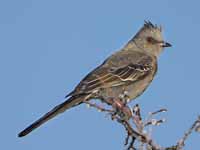BIRDS of THE WORLD - An Online Bird Book
Order Passeriformes Family Bombycillidae - 1 genus
WAXWINGs
Order Passeriformes Family Bombycillidae - 1 genus
This family has only genus Bombycilla, the waxwings. All three species have mainly brown plumage, a black line through the eye and black under the chin, a square-ended tail with a red or yellow tip, and a pointed crest. When available they eat fruit. Waxwings will also eat sap, buds, flowers, and insects.
Genus Bombycilla
Waxwing,_Bohemian Bombycilla garrulus Found: northwest North America, Europe, Asia
The Bohemian Waxwing has gray upperparts and lowerparts, black mask fringed with white, black throat, yellow or orange tipped tail.
Similar to: Cedar Waxwing. Cedar Waxwing has more brown than Bohemian Waxwing which is mostly gray. Bohemian Waxwing has larger black patch on throat. Bohemian Waxwing is stouter.
Image by: 1) Tatiana Bulyonkova - Siberia Shawn McCready - Alberta, Canada 3) Andreas Nilsson 4) Randen
Pederson Similar to: Cedar Waxwing. Cedar Waxwing has more brown than Bohemian Waxwing which is mostly gray. Bohemian Waxwing has larger black patch on throat. Bohemian Waxwing is stouter.




Waxwing,_Cedar Bombycilla cedrorum Found: North America, north South America
The Cedar Waxwing has a brown crest, black mask fringed with white, black throat, light brown neck and breast, yellowish belly, yellow or orange tipped tail.
Similar to: Bohemian Waxwing. Cedar Waxwing has more brown than Bohemian Waxwing which is mostly gray. Bohemian Waxwing has larger black patch on throat. Bohemian Waxwing is stouter.
Similar to: Phainopepla. Phainopepla does not closely resemble Cedar Waxwing except for its general shape.
Image by: 1, 3, 4) Dick Daniels - North Carolina 2) Dick - Acadia National Park, Maine 5) Becky_Matsubara - CA 6, 7) Gary Mercier - Quebec citySimilar to: Bohemian Waxwing. Cedar Waxwing has more brown than Bohemian Waxwing which is mostly gray. Bohemian Waxwing has larger black patch on throat. Bohemian Waxwing is stouter.
Similar to: Phainopepla. Phainopepla does not closely resemble Cedar Waxwing except for its general shape.
6) Eating frozen crab apples







Waxwing,_Japanese Bombycilla japonica Found: northeast Asia
The Japanese Waxwing has mainly pinkish-brown plumage; pointed crest; black throat; black eye-stripe; pale yellow center of belly; black tail with red tip.
Image by: 1) Jason Buberei 2) Hiyashi Haka 3, 4) Conifer conifer



The Palmchat is the only species in the genus Dulus and the family Dulidae. It is thought to be related to the waxwings, family Bombycillidae, and is sometimes classified with that group. The name reflects its strong association with palms for feeding, roosting and nesting.
Genus Dulus - 1 species
Palmchat Dulus dominicus Found: Dominican Republic, Haiti, nearby islands
The Palmchat has olive-brown upperparts; buff underparts heavily streaked with brown; yellow bill.
Image by: 1) Luis Alberto 2) Ron Knight - Dominican Republic 3) Pedrito Guzman - Dominican Republic


There is only one genus in this family..
Genus Hylocitrea - 1 species
Hylocitrea also Yellow-flanked Whistler Hylocitrea bonensis Found: Indonesian island of Sulawesi
The Hylocitrea been considered a member of family Pachycephalidae or familyBombycillidae,[
Image by: 1) Adolf Meyer 2) Anthony Overs

The silky-flycatchers family contains only four species in three genera. They were formerly lumped with waxwings in the family Bombycillidae. The family is named for their silky plumage and their aerial flycatching techniques. . Almost all species have small crests. They range in size from 18–25 cm in length and are mostly slender birds. Juveniles birds of both sexes are colored like the female. They eat fruit or insects. They occur mainly in Central America.
Genus Phainopepls - 1 species
Phainopepla Phainopepla nitens Found: southwest North America and Central America
The Phainopepla has a crest, long tail, short and slender bill. The male is glossy black; the female is plain gray. Both sexes have red eyes, but these are more noticeable in the female than the male.
Similar to: Cedar Waxwing, Northern Cardinal, Northern Mockingbird. Phainopepla does not closely resemble any of these species except for its general shape.
Image by: 1) Alan Vernon 2) Searchnet Media 3) Dick Daniels - Arizona 4) Ted Grussing - Arizona 5) Elaine R Wilson - Near Superior, Arizona 6) New Jersy Birds 7) Chris Queen - Arizona Similar to: Cedar Waxwing, Northern Cardinal, Northern Mockingbird. Phainopepla does not closely resemble any of these species except for its general shape.
1, 2) Female 3, 4, 5, 6) Male







Genus Phainoptila - 1 species
Flycatcher,_Black-and-yellow_Silky- also Black-and-yellow Phainoptila Phainoptila melanoxantha Found: Costa Rica, Panama
The male Black-and-yellow Flycatcher has black mantle, head, tail, wings; yellow flanks, rump; olive breast; gray belly. Female has blackish cap; olive upperparts, wings, breast; yellow flanks; gray nape, throat, belly.
Image by: 1) John_Gerrard_Keulemans 2) Eveha 3) Hans_Zwitzer - Costa Rica1) Male - top; female - bottom 2) Female 3) Male



Genus Ptiliogonys
Flycatcher,_Gray_Silky- Ptiliogonys cinereus Found: Guatemala, Mexico
The Gray Silky-Flycatcher has brownish-gray to gray upperparts; long slender tail; prominent crest; pale eye-ring; underparts vary from deep gray to golden olive depending on sex and subspecies.
Image by: 1) Ron_Knight - western Mexico 2) Francesco_Veronesi - Mexico 3) Daniel_Beper - Mexico


Flycatcher,_Long-tailed_Silky- Ptiliogonys caudatus Found: Costa Rica and western Panama
The male Long-tailed Silky-Flycatcher has blue-gray back; lower-breast, upper-belly; yellow crested head with pale gray forehead; yellow neck, throat, lower belly; black pointed tail feathers. Female has darker gray forehead; olive body; shorter and duller black tail.
Image by: 1) Chris_Jimenez 2) David_Rodriguez_Arias - Costa Rica 3) Francesco_Veronesi - Panama

